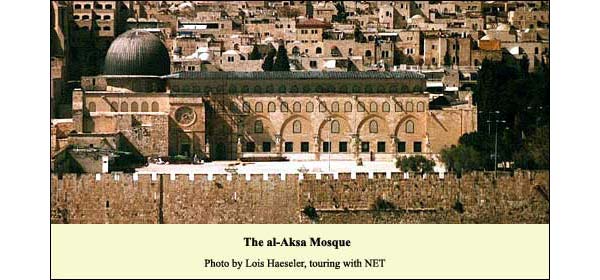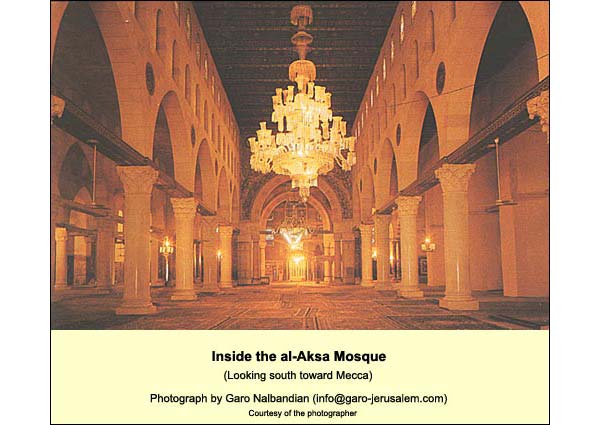Al-Aqsa Mosque

After leaving our shoes (see Logistics), we enter through the porch (its three middle bays are Crusader). We find ourselves in a great hall, whose parts derive from different times. Little attempt has been made to preserve the unity of detail we saw in the Dome. There are large white pillars of a purer marble than any in the land. They hail from Carrara, a gift of Mussolini. (He meant them perhaps as a gesture of reconciliation after his treatment of the Muslims in Libya.) On the west side we do not see them, for there the earthquakes did not damage the mosque.

The painted wooden roof was a gift of Egypt's King Farouk. On the southern end is the mihrabMihrab: a niche or depression in a wall, e.g. of a mosque, indicating the kibla: the direction toward Mecca, for the purpose of Muslim prayer. , which goes back to Saladin. (He also gave a pulpit (minbar) carved out of cedar wood, which a crazed Australian burned in 1969, hoping thus to bring the Messiah.) The great arch before the mihrab is the oldest part of the current building: it dates to repairs that followed the earthquake of 1033. The overall impression is one of immense solemnity, as if the desert were incorporated in a building. The absence of seats plays a part in this impression: a seat would merely obstruct the Muslim in prayer. Logistics for a visit. {mospagebreak title=Muslim Prayer} Muslim Prayer According to Islamic belief, God ordained the ritual of prayer during Muhammad's visit to heaven. There are seven postures, together called a "bowing" or "inclination." The Muslim prays five times per day, and each time he or she includes a specific number of bowings: two at daybreak, four at noon, four in mid-afternoon, three after sunset, and four in the early part of the night. A caller (muezzin) makes the summons to prayer from the minaret of a mosque: "Allahu aqbar," he sings: "God is most great." After repeating this, he sings on: "I bear witness that there is no god but the one God, I bear witness that Muhammad is his Prophet. Come to the prayer. Come to the Good. Prayer is better than sleep. God is most great, God is most great. There is no god but the one God."
On Friday at noon and on holidays, there is congregational prayer.
The order of a bowing proceeds as follows. (1) One begins by standing upright. Hands open on either side of the face, one recites, "God is most great." (2) One lowers the hands and recites the opening sura (chapter) of the Koran:"Praise be to God, the Lord of the worlds, The Merciful One, the Compassionate One, Master of the Day of Judgment. You alone we serve, to you alone we cry for help. Guide us in the straight path, the path of those you have blessed, not that of those with whom you are angry, nor that of those who go astray." Then one recites a sura from the last part of the Koran and (3) bends forward, hands on knees, back straight. One raises the head and says, "God hears those who praise him," then (4) stands erect once more, serene, and then (5) goes directly into a prostration. One says, "God is most great!" while leaning forward, touching the forehead and nose to the ground. (Thus one has gone from standing to smallness.The word Islam means submission: to the will of God.) The prayer continues: the Muslim (6) sits back, (7) makes a second prostration, then rises and repeats the postures, though with different recitations. On sitting back once more, he or she utters a prayer for peace "upon you, O Prophet! Peace upon us all, all righteous servants of God." And then comes the Word of Witness (shahada), whose recitation is one of the five basic duties, or the pillars of IslamThe five Pillars of Islam: 1. The confession of faith: that there is no god but the one God, and Muhammad is His servant and messenger. 2. Regular performance of the ritual of prayer. 3. The giving of money for the relief of the needy. 4. The fast during Ramadan, the ninth month of the lunar year (the Muslim fasts during the daylight hours for the entire month). 5. The pilgrimage (haj) to Mecca., laid on the individual Muslim: "I witness that there is no god but the one God. Muhammad is His servant and messenger."Then one says, "Peace be upon you," looking straight ahead toward the qiblahThe direction of Muslim prayer, indicated in a mosque by the mihrab, a niche or alcove. and turning the head to the right. In congregational prayer, one acknowledges, by turns of the head, the person to the right, the imam (prayer leader) before one, and the person to the left.